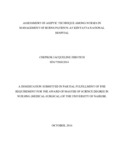| dc.contributor.author | Chepkok, Jacqueline J | |
| dc.date.accessioned | 2016-11-15T07:17:16Z | |
| dc.date.available | 2016-11-15T07:17:16Z | |
| dc.date.issued | 2016-10 | |
| dc.identifier.uri | http://hdl.handle.net/11295/97213 | |
| dc.description.abstract | Background: Nurses are at greater risk of acquiring and transmitting Health Care Acquired
Infections (HCAI) in the course of delivering nursing care; measures to prevent the transmissions
are therefore a significant core nursing care. Aseptic Technique among nurses in infection
control during management of burns plays a vital role in reducing their morbidity and mortality
and hence cost of burn wound management at individual and national level. Therefore, HCAI is
the most serious complication of burns with sepsis being the main cause of death. Adherence to
the standard operating procedures on burns management put in place by KNH on aseptic
techniques assist in preventing infection spread. The aim of this study was to assess aseptic
technique among nurses in management of burns patients at KNH.
Methods: A cross sectional descriptive study design was employed to obtain sample size 59
nurses working in the burns wards, KNH. A self administered questionnaire and structured
observational checklist was used to collect data. Data was coded and analyzed using SPSS
version 21, descriptive statistics such as median, mean and frequency distribution were applied
and categorical data was analyzed using chi-square. Measurements of association between the
independent variables with key dependent variable were ascertained through logistical regression
modeling.
Results: 42.9% of the participants did not wash their hands properly before, during and after the
dressing procedure while 88.1% had good knowledge on aseptic technique; however 14.6% of
the participants maintained the aseptic technique practice throughout the procedure while 85.4%
did not. Statistical significance was found between barriers to aseptic technique and adequate
water supply in the taps and soap at P=0.038(OR=4.5). 70.7% of the rooms lacked standard
operating procedures on infection prevention. Presences of segregation posters were present at
31.6 % of the rooms. Barriers to aseptic technique implementation were noted by 54.8% of the
nurse’s in hindering application of knowledge to practice.
Conclusion: Nurses working in the burns specialized units have adequate knowledge on aseptic
technique and a major key role to play in the prevention of sepsis during burns patient
management, but exhibit fair adherence in practice.
Recommendations: This results suggest that nurses in the specialized wards need to be re
-trained on aseptic technique procedures by the institution and institutional policies be availed
to the respective ward departments, in addition to adequate logistics on supplies and equipments
Aseptic technique surveillance needs to be improved from the managerial to the ward level to
maintain the Standard Operating Procedures. | en_US |
| dc.language.iso | en | en_US |
| dc.publisher | University of Nairobi | en_US |
| dc.title | Assessment of aseptic technique among nurses in management of burns patients at Kenyatta national hospital | en_US |
| dc.type | Thesis | en_US |
| dc.description.department | a
Department of Psychiatry, University of Nairobi, ; bDepartment of Mental Health, School of Medicine,
Moi University, Eldoret, Kenya | |

